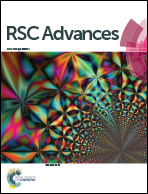Fluorescent active ruthenium(ii) complex units containing bpy or phen or dmp ligands anchored on branched poly(ethylenimine): DNA binding and in vitro biological assessment†
Abstract
Anticancer targeted ruthenium(II) complex units containing bpy(2,2′-bipyridine), phen(1,10-phenanthroline) or 2,9-dmp(2,9-dimethyl 1,10-phenanthroline) anchored on a branched polyethylenimine molecule (RuL-BPEI) were synthesised. These complexes are highly stable, emissive, redox active and show a quasi-reversible response in cyclic voltammetry. Synthesised compounds were characterized by infra-red, UV-visible, NMR, CHN, and AES analysis methods. The interaction of these RuL-BPEI samples with calf thymus DNA was explored using electronic absorption spectroscopy, emission spectroscopy, cyclic voltammetry and circular dichroism techniques. Antimicrobial activities of these polymer metal complexes have been investigated against a range of various bacteria, including clinically resistant microbes. And also anticancer properties have been tested with MCF-7 breast cancer cell lines. All results were positive.


 Please wait while we load your content...
Please wait while we load your content...